Long long time ago, when we were beginning our adventure with bread, I wanted to try and bake something with a technical challenge. I quickly chose gluten-free bread.
Dawno dawno temu, kiedy rozpoczynaliśmy naszą przygodę z chlebem, chciałm spróbować upiec coś, co byłoby technicznym wyzwaniem. Szybko wybrałem chleb bezglutenowy.
What is it about gluten that changes so much? Some information will be in our post about it, but let me quickly say that It forms a flexible mesh holding the starch and everything else. When yeast and bacteria fart, all the gas stays within the mesh and makes it expand without escaping the structure. This makes the loaf rise.
A mixture of water and gluten-free flour is like mud. No structure is formed, and the bubbles just escape. After baking you end up with some flat and crumbly something. That’s why there are additional ingredients that try to behave like gluten – in this case it’s a mix of ground linseed and psyllium husks.
The first gluten-free bread I baked was so bad I threw it whole into a bin. After a couple tries I found this one. While it has it’s cons, it works pretty much every time. It’s time to share my secret recipe (almost – it’s not mine, and it’s publicly available in here). I removed sugar as I’m not a fan of adding sugar to bread, and replaced oat flour with millet, as friends who can eat a little gluten mentioned that non-gf-classified oats usually have a little too much of it.
Planning
It’s either a night-day or day-night flow. You make the levain and wait throughout the night, then let it rise through the day and bake it, or make the levain in the morning, the bread in the evening and bake in the morning.
Ingredients
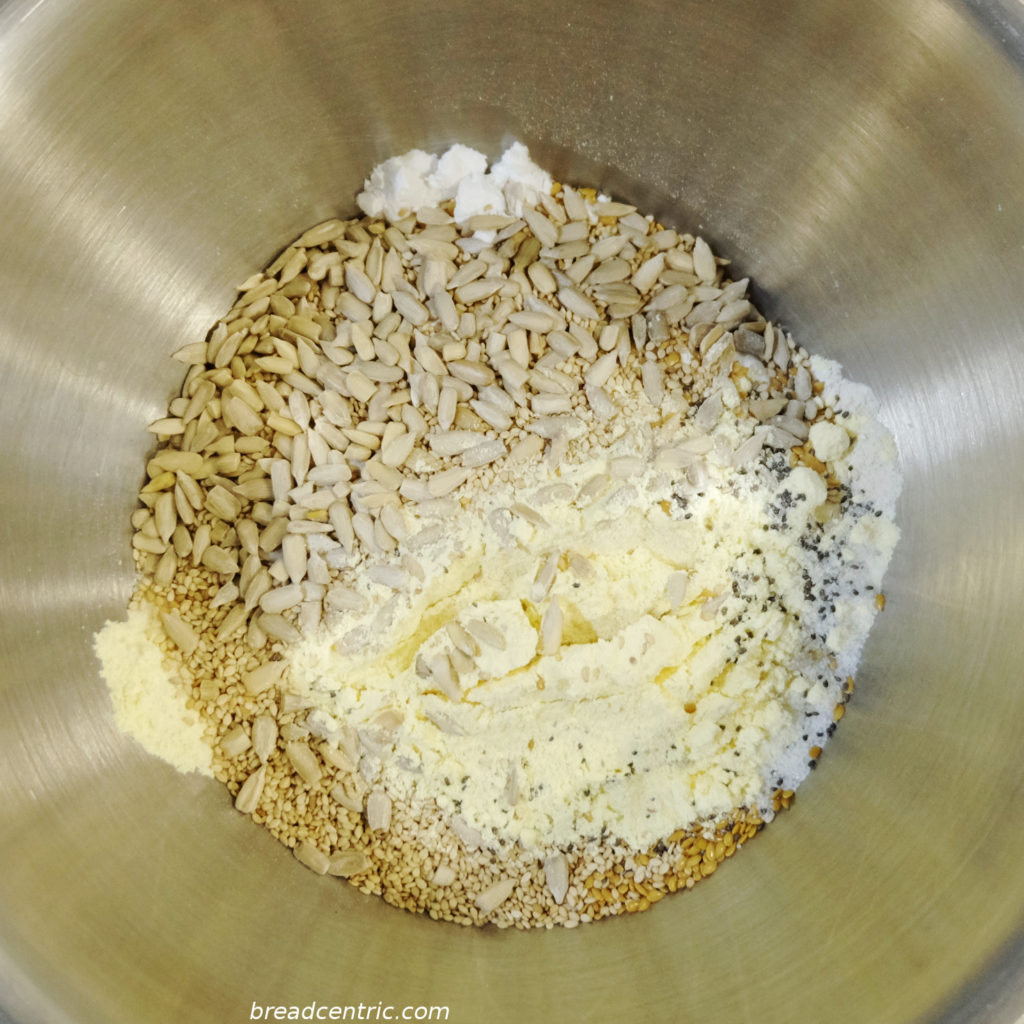
Levain
- 80 g sorghum flour (I used to use brown rice flour, but sorghum tastes better)
- 110 g water
- 140 g brown rice sourdough
Wet mixture
- Levain
- 10 g ground linseed
- 20 g psyllium husks
- 350 g water
The dough
- Wet mixture
- 60 g millet flour
- 60 g potato flour
- 60 g corn flour
- 60 g teff flour (I used to use buckwheat flour but then learned I didn’t like it)
- 20 g sunflower seeds
- 20 g linseed
- 20 g sesame seeds
- 10 g chia seeds
- 10 g salt
Preparation
- Mix the levain and leave to mature for about 8-12 hours
- In a second bowl add all dry ingredients of the dough. Mix them and make sure you have no lumps left
- When the levain is ready, in a third bowl add water to psyllium husks and ground linseed. Mix until they it forms a thick gel
- Combine the gel with levain and mix well
- Add the wet mixture to the dry ingredients and mix until all try ingredients get incorporated. When I am having problems, I add a little bit of water to help myself
- Place it in a loaf tin and leave it to rise for about 8-12 hours
- Set your oven to 150 C degrees with fan. Know your oven
- Cover the tin with kitchen foil. I make a dome so that the bread has some space to rise
- Place it in the oven and bake for 70 minutes. Add steam. After 40 minutes remove the foil
- Let it cool down on a cooling rack
There are times when the bread has a nice crust, but there are times when it gets all white, like this time. I’m not really sure what causes it, but it doesn’t influence the bread, which is really nice and fluffy.
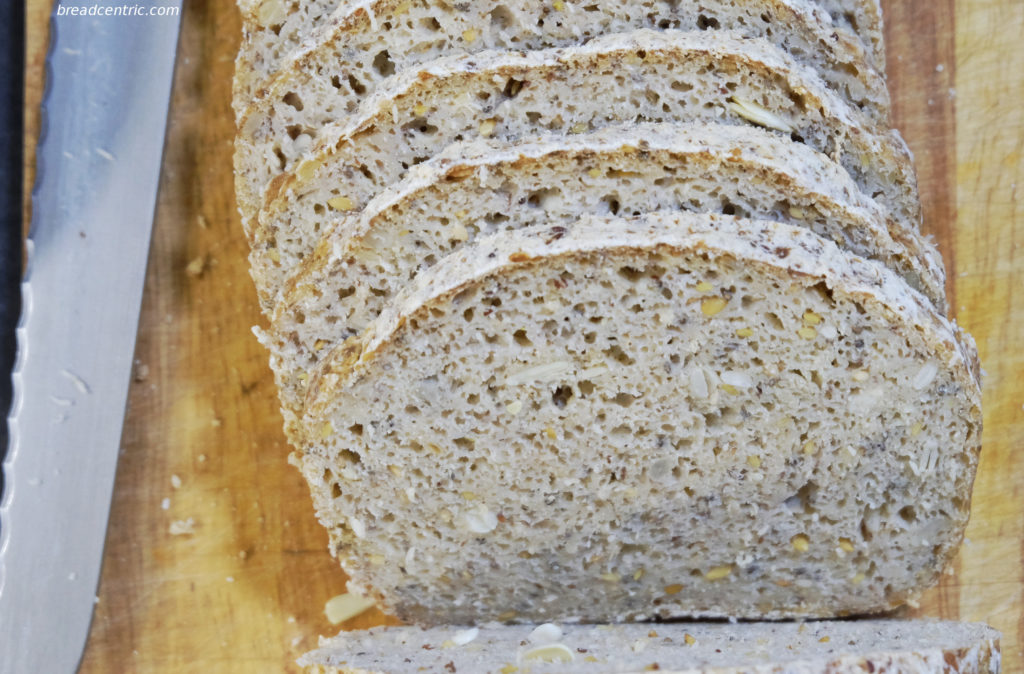
One thing I don’t really like about it is the mildly bitter taste coming from the rice flour. I’m thinking of replacing part of it. Also, I’m wondering what it would be like with guar gum it xanthan gum. I will be testing this at some point.
Update
It has been suggested to me that the bitterness may come from the buckwheat flour. I’ll check this as well, thank you Hannahalla!
Update 2017.06.06
I have tried replacing rice flour in the levain with sorghum flour and my impression is that the flavour has improved significantly, I don’t feel the bitterness any more and it is either a coincidence or this change also improved the look of the loaf.

Update 2017.09.28
I have replaced buckwheat flour with teff flour and it got even better. I’d say I’ve got the final version of this recipe, really tasty.
Co takiego jest w glutenie, co zmienia tak wiele? Trochę wyjaśnień znajdziesz w naszym wpisie o glutenie, ale na szybko napiszę, że formuje on siatkę, która trzyma skrobię i wszystkie inne składowe ciasta. Kiedy drożdże i bakterie pierdzą, cały kwas pozostaje wewnątrz siatki i rozszerza ją bez uciekania z ciasta. To powoduje rozrost bochenka.
Woda z mąką bezglutenową jest jak błoto. Nie tworzy żadnej struktury, a bąbelki zwyczajnie uciekają. Po upieczeniu wychodzi coś płaskiego, łatwo kruszącego się. Dlatego korzysta się ze składników, które próbują wykonać pracę glutenu – w tym wypadku mieszanki mielonego siemienia lnianego oraz babki płesznik.
Pierwszy chleb bezglutenowy, jak upiekłem, był tak zły, że cały poszedł do kosza. Po kilku próbach znalazłem ten. Mimo że ma swoje wady, zawsze wychodzi. Czas podzielić się moją sekretną recepturą (prawie – nie jest moja i jest otwarcie dostępna tu). Usunąłem z niej tylko cukier, bo nie jestem miłośnikiem cukru w chlebie, i zastąpiłem mąkę owsianą mąką jaglaną, ponieważ znajomi, którzy mogą zjeść troszkę glutenu, sugerowali, że glutenu w tej nieklasyfikowanej jako b/g jest w niej troszkę za dużo.
Planowanie
Możesz robić go w trybie noc-dzień albo dzień-noc. Ja zazwyczaj robię zaczyn wieczorem, rano ciasto i piekę popołudniu/wieczorem.
Składniki

Zaczyn
- 80 g mąki z sorgo (używałem wcześniej brązowej mąki ryżowej, ale sorgo smakuje lepiej)
- 110 g wody
- 140 g zakwasu na mące ryżowej
Mokre
- Zaczyn
- 10 g mielonego siemienia lnianego
- 20 g babki płesznik
- 350 g wody
Ciasto
- Mokre
- 60 g mąki jaglanej
- 60 g mąki ziemniaczanej
- 60 g mąki kukurydzianej
- 60 g mąki z miłki abisyńskiej, czyli teff (używałem gryczanej, ale dotarło do mnie, że jej nie lubię; miłka daje radę i ma fajną nazwę)
- 20 g ziaren słonecznika
- 20 g siemienia lnianego
- 20 g ziaren sezamu
- 10 g ziaren chia
- 10 g soli
Przygotowanie
- Zmieszaj składniki na zaczyn i zostaw na dojrzewanie na 8-12 godzin
- W drugiej misce umieść wszystkie suche składniki ciasta, wymieszaj je i upewnij się, że nie zostały żadne grudki
- W trzeciej misce (gdy zaczyn jest gotowy) wymieszaj babkę i len z wodą, zamieszaj aż powstanie galaretowata substancja
- Połącz galaretę z zaczynem i dobrze zamieszaj
- Dodaj mokre do suchych składników i wymieszaj, aż wszystkie składniki się wchłoną. Jeśli idzie mi ciężko pomagam sobie odrobiną wody
- Umieść w foremce i pozostaw na 8-12 godzin do wyrośnięcia
- Ustaw piekarnik na 150 stopni z termoobiegiem. Znaj swój piekarnik
- Przykryj foremkę folią. Ja robię z folii kopułę, aby chleb miał jeszcze miejsce do wyrośnięcia
- Umieść chleb w piekarniku i piecz przez 70 minut. Dodaj pary. Po 40 minutach zdejmij folię
- Ostudź chleb na kratce
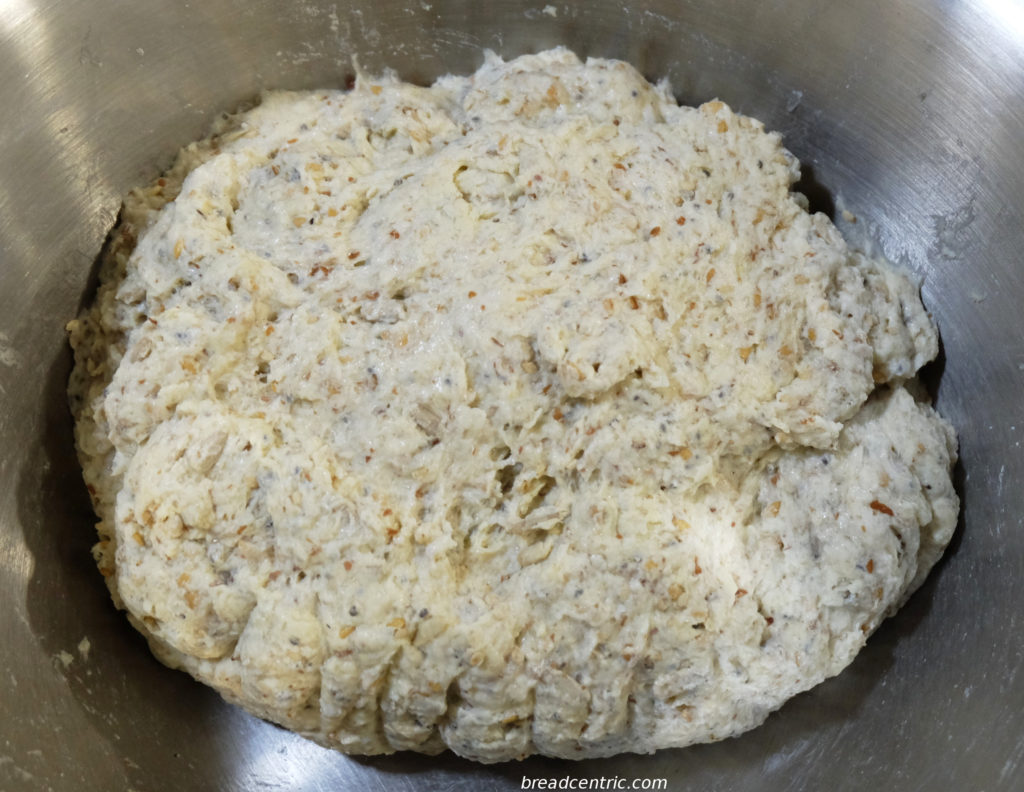

Jedna rzecz, która mi nie wychodzi za każdym razem to skórka – czasem jest ładna i rumiana, a czasem jest bardzo biała (tak jak teraz). Nie jestem piewien, skąd to się bierze, ale nie ma to wpływu na smak i konsystencję chleba, który jest smaczny i puszysty.

Jedną rzeczą, która mi nie odpowiada w tym chlebie, jest gorzkawy posmak, który chyba pochodzi od mąki ryżowej. Planuję spróbować ją zamienić na inną. Jestem też ciekaw, co się stanie, gdy zastąpię babkę gumą guar albo ksantanową. Będę to testował w niedalekiej przyszłości.
Aktualizacja
Dostałem sugestie, że gorycz może pochodzić od gryki. Spróbuję ją też zastąpić. Dzięki Hannahalla!
Aktualizacja 2017.06.06
Zastąpiłem mąkę ryżową w zaczynie mąką z sorgo i mam wrażenie, że to usunęło wspomniany gorzkawy posmak, a przynajmniej go ograniczyło. Nie jestem pewien, czy to miało jakikolwiek wpływ, ale ostatnio wygląd bochenków bezglutenowych wyraźnie się poprawił, nie robi się ta biała skorupa.

Aktualizacja 2017.09.28
Zastąpiłem grykę miłką abisyńską, czyli teffem. Zrozumiałem że mąka z gryki mi nie smakuje. Teraz to jest bardzo smaczny chleb, chyba mam już końcowy przepis.
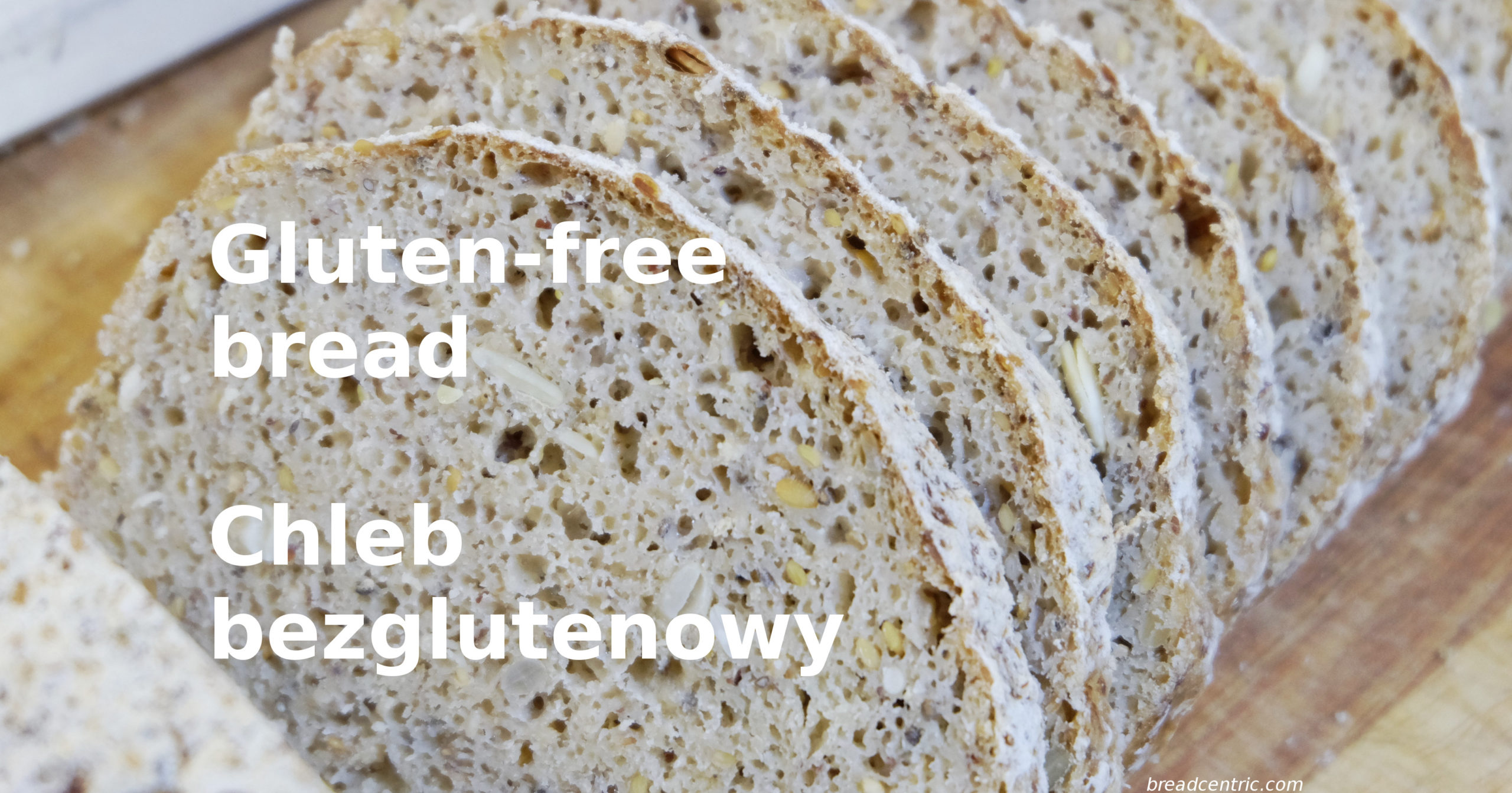
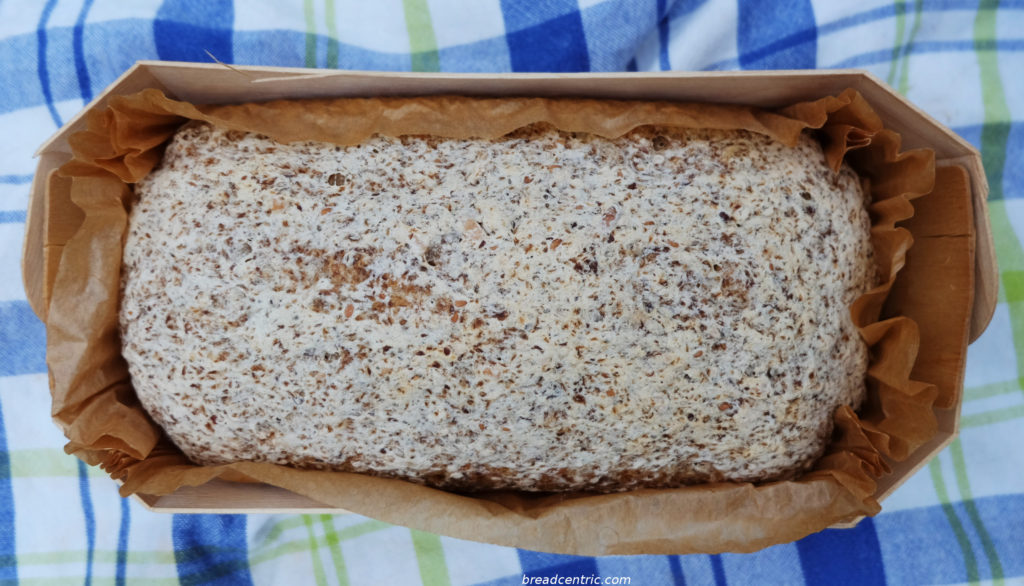
Gorzkawy posmak może pochodzić z mąki jaglanej. Te ze sklepu nie zawsze są parzone przed zmieleniem, dlatego nie jest z nich usuwana goryczka.
Dzięki za sugestię 🙂
Szczęśliwie w moim przypadku usunięcie mąki gryczanej wystarczyło.